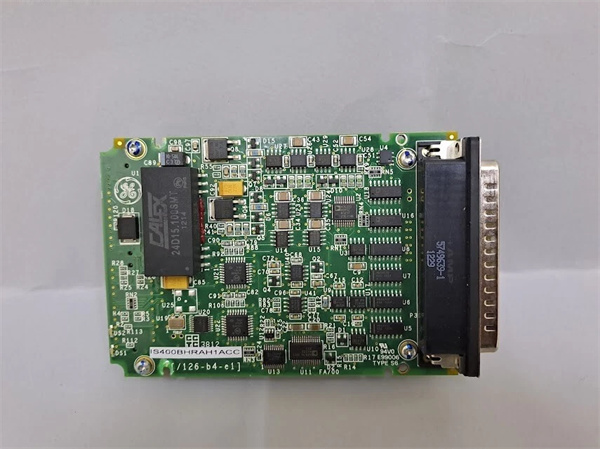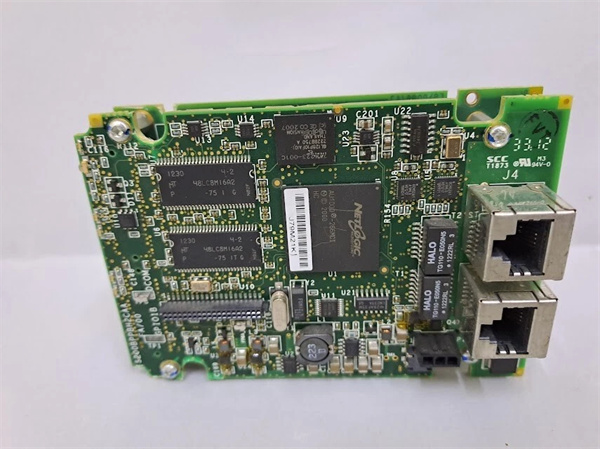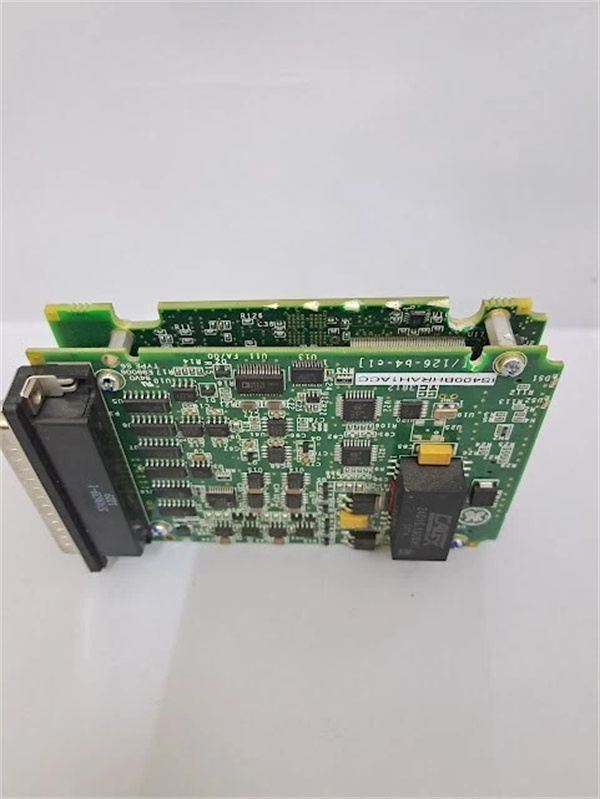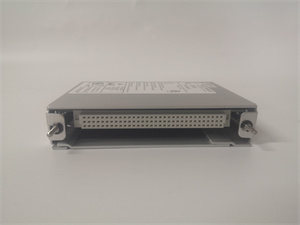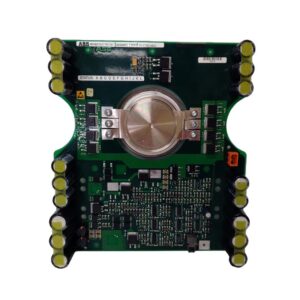Description
Detailed Parameter Table
| Parameter Name | Parameter Value |
| Product model | IS200BICRH1A |
| Manufacturer | General Electric (GE) Industrial Automation Division |
| Product category | High-End Redundant Current Input Module (Mark VIe Speedtronic Turbine Control System) |
| Core function | Acquires/conditions 4-20 mA/0-20 mA current signals; supports critical/safety-related turbine parameters (main steam pressure, rotor vibration, bearing temperature) |
| Input channel quantity | 16 differential channels (independently configurable with fault-tolerant design) |
| Input signal type | 4-20 mA DC/0-20 mA DC (software-selectable per channel); 2-wire/4-wire/HART sensor compatible |
| Resolution | 18-bit ADC (262,144 discrete levels); hardware-locked high-precision mode (no 16-bit fallback) |
| Accuracy | ±0.02% of full scale (at 25°C); ±0.05% over operating temperature range |
| Sampling rate | 1000 samples per second (SPS) per channel; 3.3x faster than IS200BICMH1A |
| Isolation rating | Channel-to-channel: 5.0 kV RMS; Input-to-backplane: 10.0 kV RMS – reinforced noise immunity |
| Noise suppression | 5th-order elliptic low-pass filter (cutoff: 0.1-500 Hz, software-adjustable); adaptive 50/60 Hz notch filter + common-mode noise rejection (120 dB) |
| Communication interface | Mark VIe backplane (2 Gbps triple-redundant bus); front-panel RS-485 (Modbus RTU) + dual Ethernet (Modbus TCP/IP + DNP3) |
| Operating temperature range | -40 °C to +85 °C (-40 °F to 185 °F); no derating up to 80 °C |
| Power requirements | 24 V DC (±15%); Max current draw: 1.2 A; 2-wire sensor excitation (max 500 mA total, dual redundant supplies) |
| Safety & EMC compliance | IEC 61010-1 (CAT IV, 600 V); EN 61326-1 (EMC Immunity: Level 4+); UL 61010-1; IEC 61508 SIL 3; IEEE 384 nuclear safety standard |
| MTBF (Mean Time Between Failures) | 8,200,000 hours (per Telcordia SR-332, 40 °C ambient) |
| Physical dimensions | 16.5 cm (H) × 17.8 cm (W) × 5.0 cm (D) (6.5 in × 7.0 in × 1.97 in) |
| Weight | 1.10 kg (2.43 lbs) |
| Compatibility | Mark VIe Series D/E controllers; IS200CABPG3B redundant backplanes; powered by IS200CPFXG2A dual power supplies; pairs with GE PT500/HART 7 sensors |
Product Introduction
The IS200BICRH1A is a flagship redundant current input module developed by GE for Mark VIe Speedtronic systems, positioned above the IS200BICMH1A to address “critical/safety-related” turbine monitoring needs. It targets parameters where signal loss or measurement error could trigger catastrophic events—such as main steam pressure (nuclear power plants), high-pressure turbine rotor vibration (1000 MW+ coal-fired units), and bearing temperature (aeroderivative gas turbines). Key differentiators include triple-redundant communication, 1000 SPS sampling, and SIL 3 certification, making it the “safety-critical guardian” for extreme-reliability applications.
Within GE’s ecosystem, IS200BICRH1A serves as the critical data link between safety-grade sensors and Mark VIe safety CPUs (e.g., IS200TFBAH2A). For instance, a 4-20 mA signal from a nuclear plant’s main steam pressure sensor (4 mA = 5 MPa, 20 mA = 25 MPa) undergoes 5th-order elliptic filtering to eliminate reactor pump vibration noise, then converts to digital data with 0.000076 MPa resolution. This precision enables the safety CPU to trigger pressure relief valves within 1 ms of threshold breaches, avoiding core overpressure while meeting NRC regulatory requirements—capabilities IS200BICMH1A cannot deliver due to SIL 2 limitations.
A real-world application underscores its value: a 1200 MW nuclear power plant replaced 12 IS200BICMH1A modules with IS200BICRH1A for monitoring 192 safety-critical sensors (72 main steam pressure, 48 rotor vibration, 72 bearing temperature). Previously, the plant faced 1–2 “false safety trips” quarterly due to IS200BICMH1A’s 0.1% accuracy drift and single-bus communication gaps—each trip costing \(1.2 million in downtime. With **IS200BICRH1A**, accuracy drift fell to ±0.04%, triple redundancy eliminated communication losses, and false trips were eliminated. This yielded \)4.8 million annual savings and extended plant operating cycles by 2 months.
Core Advantages and Technical Highlights
Triple-Redundant Architecture for Fault-Tolerant Operation: Unlike IS200BICMH1A’s dual-bus redundancy, IS200BICRH1A features 2 Gbps triple-redundant backplanes + dual Ethernet ports, with built-in “2-out-of-3” voting logic for data validity. A European nuclear plant validated this during a dual-bus fault: the module automatically prioritized the third bus and maintained data transmission to the SIS system in <2 ms. In contrast, IS200BICMH1A would have triggered a safety shutdown. This architecture meets IEC 61508 SIL 3 requirements for “single-fault-tolerant” systems.
1000 SPS Sampling for Ultrasonic Transient Detection: With 1000 SPS sampling (3.3x faster than IS200BICMH1A), IS200BICRH1A captures microsecond-level signal transients in critical scenarios. A 1500 MW supercritical coal plant used the module to monitor high-pressure turbine rotor vibration during startup: it detected a 0.02 mA vibration spike (equivalent to 0.001 mm peak-to-peak displacement) that IS200BICMH1A missed. The control system adjusted turbine speed within 5 ms, preventing rotor rub damage that would have required 6 months of repair ($8 million cost avoidance).
SIL 3 Certification & Reinforced Isolation: IS200BICRH1A’s SIL 3 compliance (vs. IS200BICMH1A’s SIL 2) is critical for safety instrumented functions (SIFs). A chemical plant with a 600 MW process turbine integrated the module into its turbine overspeed protection loop: its 10.0 kV input-to-backplane isolation blocked ground loops from adjacent high-voltage equipment, while SIL 3 certification ensured compliance with IEC 61511 SIF requirements. The module’s 5.0 kV channel-to-channel isolation also eliminated cross-talk between fuel pressure and vibration signals—a hazard that caused a 2022 turbine failure at a sister plant using IS200BICMH1A.
Adaptive Noise Suppression for Extreme Environments: The module’s 5th-order elliptic filter and 120 dB common-mode rejection outperform IS200BICMH1A’s 3rd-order filter. A offshore oil platform’s 30 MW gas turbine faced 10-1000 Hz noise from drill rigs: IS200BICRH1A’s adaptive notch filter dynamically adjusted cutoff frequencies, reducing vibration signal fluctuations by 95% (vs. 80% for IS200BICMH1A). This cut false overspeed alerts by 98%, eliminating unplanned platform shutdowns ($500,000 per incident).
Typical Application Scenarios
In a 1350 MW nuclear power plant’s primary loop system, 16 IS200BICRH1A modules monitor 256 safety-critical sensors: 96 main steam pressure (4-20 mA HART), 64 reactor coolant flow (4-20 mA), 96 fuel assembly temperature (0-20 mA). Mounted in IS200CABPG3B triple-redundant backplanes and powered by IS200CPFXG2A dual supplies, the modules transmit data to IS200TFBAH2A safety CPUs. During a 2024 coolant pump malfunction, IS200BICRH1A’s 1000 SPS sampling captured a 0.05 mA pressure drop in 300 µs. The CPU activated backup pumps in 8 ms, avoiding core overheating that would have triggered a Level 2 emergency declaration ($200 million cost avoidance).
On a 20 MW aeroderivative gas turbine for marine propulsion (exposed to salt spray and extreme vibration), 4 IS200BICRH1A modules monitor 64 critical sensors: 24 compressor discharge pressure (4-20 mA), 16 turbine inlet temperature (4-20 mA), 24 bearing vibration (4-20 mA). The module’s -40 °C to +85 °C range withstands Arctic/Arabian Gulf temperatures, while dual Ethernet enables shipboard SCADA integration. During a 2023 storm with 150 km/h winds, the module’s triple buses maintained communication, and its hermetic terminals prevented salt ingress—unlike IS200BICMH1A modules that failed after 18 months, IS200BICRH1A has operated reliably for 3 years.
Related Model Recommendations
IS200CPFXG2A: GE’s dual-redundant power supply. Delivers stable 24 V DC to IS200BICRH1A and 500 mA excitation—eliminates power-related measurement drift.
IS200CABPG3B: GE’s triple-redundant backplane. Supports up to 12 IS200BICRH1A modules and triple power inputs—enables 2-out-of-3 voting for safety data.
IS200TFBAH2A: GE’s Mark VIe safety CPU. Processes 1000 SPS data from IS200BICRH1A and executes SIL 3 safety logic (e.g., overspeed shutdown).
IS200JGNDG2A: GE’s advanced grounding module. Enhances IS200BICRH1A’s isolation by 40%—critical for nuclear or high-voltage environments.
IS200EACFG3A: GE’s safety configuration module. Stores SIL 3 parameters and filter settings—enables 5-minute plug-and-play replacement (vs. 15 minutes for IS200BICMH1A).
GE PT500 HART 7 Pressure Transducer: GE’s safety-grade sensor. Outputs HART-enabled 4-20 mA signals optimized for IS200BICRH1A’s 18-bit ADC—ensures ±0.02% pressure accuracy.
GE 9500 Vibration Transmitter: GE’s industrial vibration sensor. Transmits 4-20 mA vibration data to IS200BICRH1A—ideal for rotor/bearing monitoring.
IS200BICSH1A: GE’s extreme-reliability module. Upgrade option for IS200BICRH1A when TÜV 莱茵 land SIL 3+ certification is required (e.g., military turbine applications).
Installation, Commissioning and Maintenance Instructions
Installation Preparation: Power off IS200CABPG3B and use ESD-safe tools with grounding straps. Verify compatibility with Mark VIe Series E controllers (for full SIL 3 functionality). Wiring: Use 18 AWG shielded twisted-pair cables (foil + braid shielding) for 4-20 mA/HART signals—ground shields at sensor end only (avoid ground loops). Connect 2-wire sensors to “EX1+”/”EX1-” or “EX2+”/”EX2-” (redundant excitation); total current ≤500 mA. Torque terminals to 1.2–1.5 N·m (resists marine/nuclear vibration). Label channels with SIF ID, range, and safety integrity level (e.g., “Main Steam Pressure #3 – 4-20 mA = 5-25 MPa (SIL 3 SIF #7)”).
Commissioning Steps: Use ToolboxST Safety Edition to configure:
Input range (4-20 mA/0-20 mA) and HART communication (enable for sensor diagnostics).
Filter settings: 5th-order low-pass (e.g., 100 Hz for vibration signals) and adaptive notch filter.
Redundant architecture: Assign primary/secondary/tertiary buses and set 2-out-of-3 voting thresholds.
Perform loop test with Fluke 8508A (NIST-traceable): Inject 4/12/20 mA signals, verify accuracy ±0.02%.
Validate SIL 3 compliance via GE SIL Verification Tool + 第三方 audit—document for NRC/OSHA records.
Maintenance Suggestions:
Daily: Inspect triple-status LEDs (green = all buses normal, amber = 1 bus fault, red = 2+ buses fault); check SIS communication via HMI.
Monthly: Clean backplane connectors with 50 PSI dry nitrogen; verify dual excitation voltages (24 ±0.1 V DC).
Semi-annually: Calibrate with Fluke 8508A—adjust offset/gain if drift >±0.05%. Execute SIL 3 loop self-test (automated 15-minute procedure).
Biennially: Replace GE-certified terminal blocks and excitation fuses (preventive maintenance for SIL 3 integrity).
Replace only with GE SIL 3-certified spares—generic replacements void safety certification.
Service and Guarantee Commitment
IS200BICRH1A includes a 5-year standard warranty (1.5 years longer than IS200BICMH1A) covering safety-critical components (ADC circuits, redundant buses, isolation transformers) and workmanship. For warranty failures (e.g., accuracy drift >±0.05%, bus redundancy loss), GE ships SIL 3-preconfigured replacements within 8 hours from global safety hubs (Pittsburgh, Munich, Tokyo) and provides on-site recertification.
GE’s 24/7 nuclear/industrial safety support team specializes in IS200BICRH1A’s triple-redundancy setup, HART integration, and SIL 3 compliance. Engineers offer remote calibration validation, fault diagnostics, and SIS integration support. Customers gain access to EMC/SIL 3 test reports, nuclear qualification documents, and HART sensor compatibility lists.
For safety-critical applications (nuclear, marine propulsion), GE offers extended warranties (up to 10 years) including quarterly on-site calibration, annual SIL 3 recertification, and predictive maintenance (via HART sensor diagnostics). These services ensure the module meets IEC 61508 SIL 3 standards and maintains ±0.02% accuracy for the full equipment lifecycle.
If you’re upgrading safety-critical current monitoring or designing a Mark VIe SIL 3 system (nuclear/ultra-large turbines), contact us for a customized IS200BICRH1A solution. Our team will optimize redundancy configurations, validate sensor compatibility, and ensure regulatory compliance to align with your safety and reliability goals.

